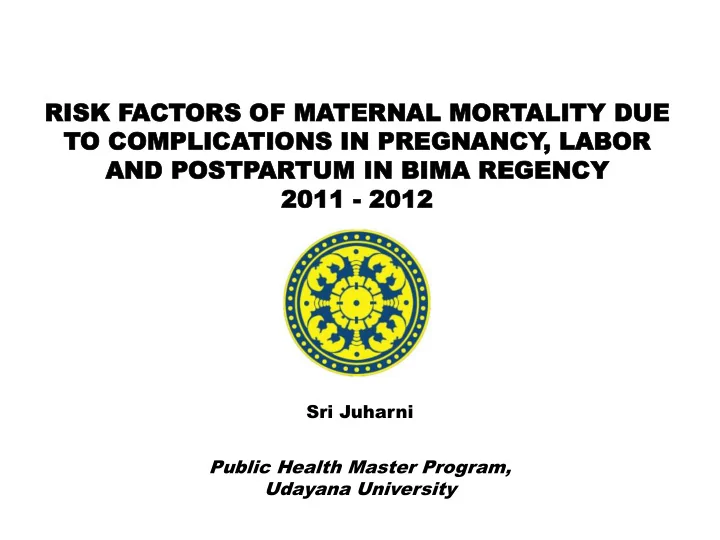

RI RISK F SK FACT CTOR ORS O S OF M F MATERN TERNAL AL MO MORTALI ALITY TY DU DUE E TO O CO COMPLIC MPLICATIO TIONS IN NS IN PR PREGN EGNAN ANCY CY , , LAB LABOR OR AN AND D POSTP POSTPAR ARTUM TUM IN IN BI BIMA MA REGEN REGENCY CY 2011 2011 - 2012 2012 Sri Juharni Public Health Master Program, Udayana University
The he ba backg kgrou ound nd The Maternal Mortality Rate → basic indicators of maternal health care and women of reproductive age. More than 90% of maternal deaths → complications during pregnancy, childbirth and postpartum (Depkes RI, 2004)
The Maternal Mortality Rate in West Nusa Tenggara Province in 2010 is about 350/100,000 live births. This figure is higher than national and other provincial figures.
Bima is a regency of West Nusa Tenggara Province who has high maternal mortality cases for period of 2011 -2012, namely 20 cases.
The Ministry of Health of Indonesia classified 3 factors that affect maternal mortality, namely: medical factors non-medical factors health service factors.
• The medical factors is maternal age, parity, nutritional status, the levels of hemoglobin • The non-medical factors is Antenatal care, delayed decision-making if experiencing of the complications, Transportation access • The health service factors is provider of labor, medical treatment at referral facilities.
Problem formulation What are of the medical factors, which consist of: age, parity, pregnancy length, nutritional status and the level of hemoglobin is a risk factor of maternal death? What are of the non-medical factors, which consist of: antenatal care, delays in decision making referrals, access to transportation and travel delay in referring a risk factor for maternal mortality?
What are of the health service factors, which consists of: birth attendants, the mode of delivery, the place of delivery, utilization of the health facilities, implementation of the referral, P4K (Planning and Prevention Childbirth Complications Program), PONED and the village standby is a risk factor for maternal mortality? The most dominant factor which increased the risk of maternal mortality in Bima regency?
The Objective of the research The study was aimed at finding out the risk factors that affect maternal mortality.
Specific objectives are to understand: • Relationships medical factors, which consists of: age, parity, pregnancy length, nutritional status and the level of Hemoglobin with maternal 1. mortality. • Relationships non-medical factors which consists of: antenatal care, delays in decision making referrals, access to transportation and delay in referring travel with maternal mortality. 2. • Correlation between health services which consists of: birth attendants, mode of delivery, place of delivery, utilization of health facilities, the implementation of the referral, P4K (Planning and Prevention Childbirth 3. Complications Program), PONED and the village standby with maternal mortality. • Most dominant factor that increases the risk of maternal 4. mortality in Bima regency, 2011-2012
Methodology This study is categorized into case control study with the total samples of 20 cases and 60 controls. The data were collected through interviews by using the questionnaires. The collected data were then crosschecked with the registers existing at midwives, Health Record Cards of pregnant women and verbal autopsy documents. The univariate & bivariate analyses were done using chi square test and multivariate with logistic regression
Study Findings Subjects in this study are all willing to be a respondent. Subjects in this study spread over 11 districts in Bima district with the highest death cases are the District of Sape many as 5 cases, followed by Monta much as 3 cases, Langgudu, Wera, respectively Palibelo 2 cases, then Belo, Wawo, Ambalawi, Bolo, and Donggo, each 1 case of maternal death.
The majority of maternal deaths occur during childbirth (55%), then at the time of delivery (40%), and during pregnancy as much (5%). Cause of death was hemorrhage (60%), followed preeclampsia / eclampsia (15%), puerperal infection (10%), hyperemesis gravidarum (5%), as well as diseases that worsen the condition of the mother, namely heart disease and pulmonary edema (10% ).
Multivariate analysis 95% CI OR OR P Value Risk factors Lower Upper • Parity 2,81 0,57 13,88 0,204 • Level of Hemoglobin 15,19 3,25 70,97 0,001 • Mode of delivery 3,26 0,65 16,34 0,150 • Delay in decision making 9,28 2,15 84,68 0,048 referrals • Delay in referring travel 3,57 0,20 63,50 0,386 • Delayed medical 13,162 2,281 104,86 0,027 treatment at referral facilities • Program P4K 1,47 0,27 8,00 0,656
The findings are the factors that increase the maternity mortality rate are the level of Hb less than 10 gr% (OR = 15.19; 95% CI: 3.25 – 70.97; p = 0.001), delayed decision-making (OR = 9.28; 95% CI: 2.15 – 84.80; p = 0.048) and delayed medical treatment at referral facilities (OR = 13.16; 95% CI: 2.28 – 104.86; p = 0.027).
Key points • women of pregnant who are deficient hemoglobin to contribute for Maternal Mortality, 15.19 times compared with the women of pregnant no deficient of hemoglobin • women of pregnant who are delayed decision-making if experiencing of the complications to contribute for Maternal Mortality, 9,20 times compared with the not delayed decision-making • women of pregnant who are delayed medical treatment at referral facilities to contribute for Maternal Mortality, 13,16 times compared with the not delayed decision- making
Conclusions and recommendations • The conclusion is, the most contributing factor to the maternal mortality is the level of Hb less than 10 gr%. • This research recommended that it is necessary to detect signs of pregnancy complication, delivery complication, and post delivery complication early, pregnancy planning, improve basic obstetric emergency handlings at Public Health Centers for midwives and medical doctors, and to improve better referral systems.
Recommend
More recommend